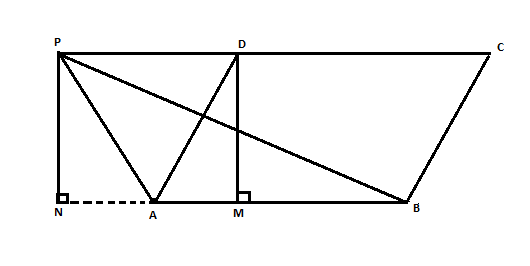
If a triangle and a parallelogram are on the same base and between the same parallels, then prove that the area of the triangles is equal to half the area of the parallelogram?
Answer
585.6k+ views
Hint: To prove the above statement we need to make some assumptions. We need to make a point outside the parallelogram and draw the line parallel to AB. Connect the point with A and B by drawing lines. Using the area of the triangle formulae we can prove the above given statement.
Complete step by step solution:
For parallelogram ABCD

Properties of Parallelogram:
1. Opposite sides are congruent (AB=DC).
2. Opposite angles are congruent (D=C).
3. Consecutive angles are supplementary (A+D= 180 degrees).
4. If one angle is the right angle, then all angles are right angles.
5. The diagonals of a parallelogram bisect each other.
6. Each diagonal of a parallelogram separates it into two congruent triangles.
Since $DM \bot AB$(DM is perpendicular to AB).
Height is DM, Base is AB
Area ABCD = Base $ \times $Height
Area ABCD = AB$ \times $DM … (1)
For $\vartriangle PAB$
Since $PN \bot AB$(PN is perpendicular to AB).
Height is PN, Base is AB
Area $\vartriangle PAB$=$\dfrac{1}{2} \times $Base$ \times $Height
$ \Rightarrow $Area $\vartriangle PAB$=$\dfrac{1}{2} \times $AB$ \times $PN
Since opposite sides of parallelogram are parallel
So, $AB\parallel CD$
$ \Rightarrow $Distances between parallel lines are equal
PN = DM (Based on the properties of Parallelogram).
$ \Rightarrow $Area $\vartriangle PAB$=$\dfrac{1}{2} \times $AB$ \times $DM … (2)
From (1) and (2)
Area $\vartriangle PAB$=$\dfrac{1}{2} \times $Area of ABCD.
Therefore, if a triangle and a parallelogram are on the same base and between the same parallels, then the area of the triangles is equal to half the area of the parallelogram.
Note: We can also prove the above statement by drawing the diagonal and the perpendiculars meeting at some point. Based on the lines collinear and parallel lines we can say the perpendiculars drawn are equal. Therefore the area of the triangle is half the area of parallelogram when having the same height and same base. (Since diagonals of a parallelogram divide it into two congruent triangles).
Complete step by step solution:
For parallelogram ABCD

Properties of Parallelogram:
1. Opposite sides are congruent (AB=DC).
2. Opposite angles are congruent (D=C).
3. Consecutive angles are supplementary (A+D= 180 degrees).
4. If one angle is the right angle, then all angles are right angles.
5. The diagonals of a parallelogram bisect each other.
6. Each diagonal of a parallelogram separates it into two congruent triangles.
Since $DM \bot AB$(DM is perpendicular to AB).
Height is DM, Base is AB
Area ABCD = Base $ \times $Height
Area ABCD = AB$ \times $DM … (1)
For $\vartriangle PAB$
Since $PN \bot AB$(PN is perpendicular to AB).
Height is PN, Base is AB
Area $\vartriangle PAB$=$\dfrac{1}{2} \times $Base$ \times $Height
$ \Rightarrow $Area $\vartriangle PAB$=$\dfrac{1}{2} \times $AB$ \times $PN
Since opposite sides of parallelogram are parallel
So, $AB\parallel CD$
$ \Rightarrow $Distances between parallel lines are equal
PN = DM (Based on the properties of Parallelogram).
$ \Rightarrow $Area $\vartriangle PAB$=$\dfrac{1}{2} \times $AB$ \times $DM … (2)
From (1) and (2)
Area $\vartriangle PAB$=$\dfrac{1}{2} \times $Area of ABCD.
Therefore, if a triangle and a parallelogram are on the same base and between the same parallels, then the area of the triangles is equal to half the area of the parallelogram.
Note: We can also prove the above statement by drawing the diagonal and the perpendiculars meeting at some point. Based on the lines collinear and parallel lines we can say the perpendiculars drawn are equal. Therefore the area of the triangle is half the area of parallelogram when having the same height and same base. (Since diagonals of a parallelogram divide it into two congruent triangles).
Recently Updated Pages
Two men on either side of the cliff 90m height observe class 10 maths CBSE

What happens to glucose which enters nephron along class 10 biology CBSE

Cutting of the Chinese melon means A The business and class 10 social science CBSE

Write a dialogue with at least ten utterances between class 10 english CBSE

Show an aquatic food chain using the following organisms class 10 biology CBSE

A circle is inscribed in an equilateral triangle and class 10 maths CBSE

Trending doubts
Why is there a time difference of about 5 hours between class 10 social science CBSE

Write a letter to the principal requesting him to grant class 10 english CBSE

What is the median of the first 10 natural numbers class 10 maths CBSE

The Equation xxx + 2 is Satisfied when x is Equal to Class 10 Maths

Which of the following does not have a fundamental class 10 physics CBSE

State and prove converse of BPT Basic Proportionality class 10 maths CBSE




